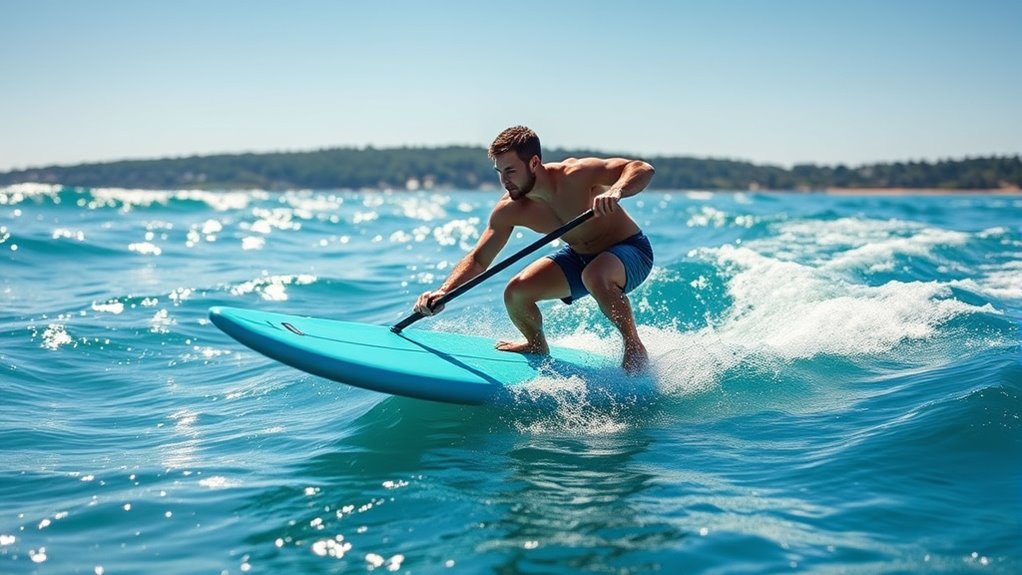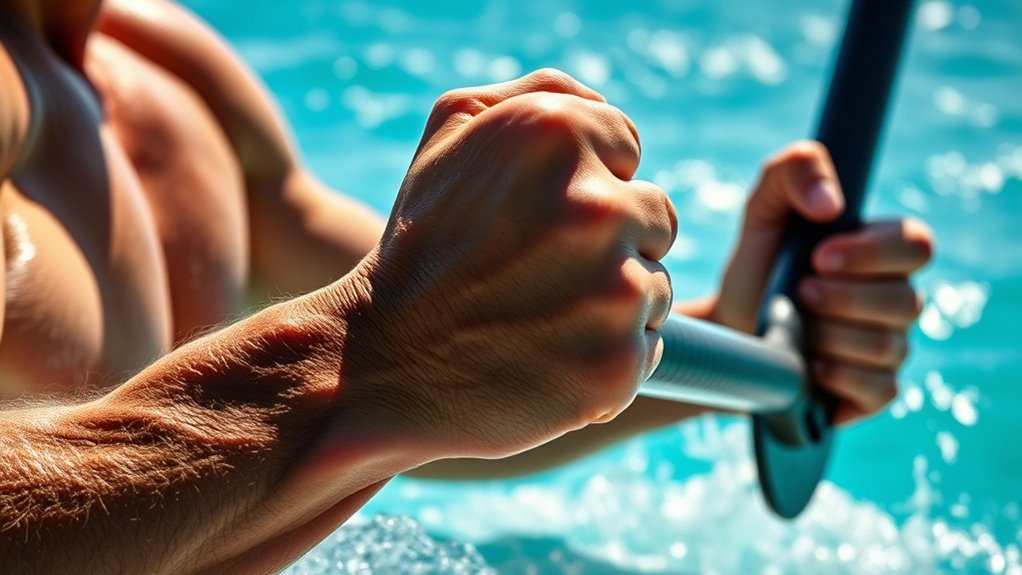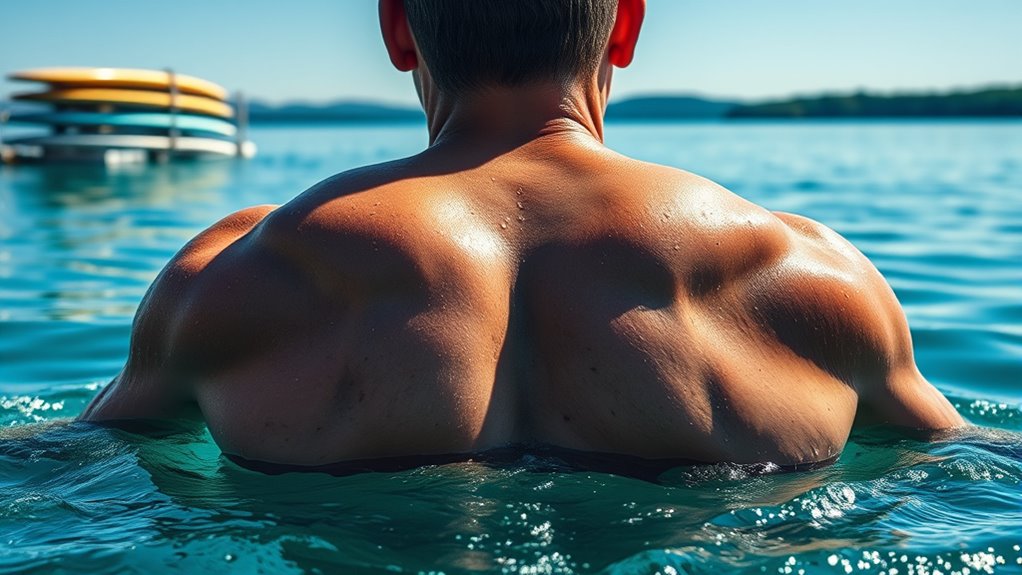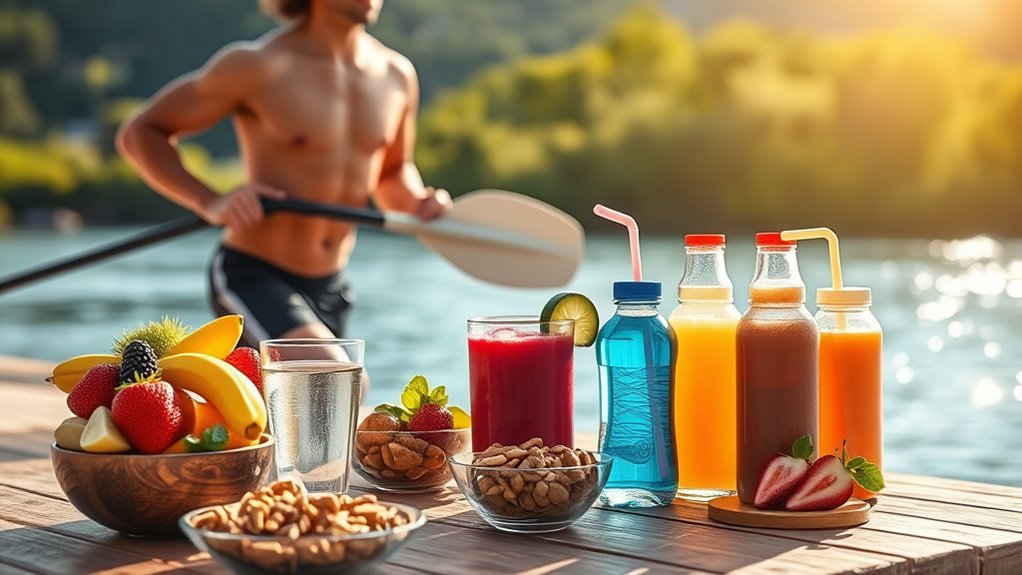To build endurance for water sports, focus on improving your cardiovascular fitness with regular aerobic exercises like swimming, cycling, or running. Incorporate sport-specific drills to refine technique and boost muscle efficiency. Strengthen essential muscles through resistance and core training, and use interval workouts to push your limits safely. Prioritize proper nutrition, hydration, and rest to support recovery. Keep tracking your progress and stay committed—if you continue, you’ll uncover even more ways to enhance your stamina and performance.
Key Takeaways
- Incorporate regular aerobic and interval training to boost cardiovascular capacity and muscular endurance.
- Gradually increase training intensity and duration, using cross-training to challenge different muscle groups.
- Practice sport-specific techniques and drills to improve efficiency and reduce fatigue during water activities.
- Strengthen core stability and major muscle groups through resistance exercises to sustain prolonged effort.
- Prioritize rest, proper nutrition, and hydration to support recovery and maintain consistent training progress.
Understand the Importance of Endurance in Water Sports

Endurance is essential in water sports because it enables you to sustain effort over long periods, helping you perform at your best even when fatigue sets in. When you’re out on the water, whether paddling, swimming, or surfing, your muscles need to work continuously. Without proper endurance, even small waves or slight fatigue can reduce your efficiency and enjoyment. Building endurance allows you to stay focused, maintain proper technique, and push through challenging conditions. It also reduces the risk of injury caused by exhaustion. By improving your stamina, you can extend your sessions, improve your skills, and gain confidence in your abilities. Additionally, understanding the role of equipment, such as proper home theatre projectors, can enhance your overall experience and comfort during extended water activities. Developing muscular endurance through targeted training can also significantly improve your performance and resilience in water sports. Incorporating cross-training can help prevent overuse injuries and build overall stamina, making your water sports sessions more enjoyable and sustainable. Engaging in activities like cycling or running can also complement your water training by boosting your cardiovascular capacity and overall fitness levels.
Incorporate Cardiovascular Training Into Your Routine

Adding regular aerobic exercises to your routine boosts your endurance and helps you recover faster during water sports. By sticking to a consistent training schedule, you’ll see steady progress and build stamina more effectively. Making cardio a habit prepares your body for the physical demands of your sport and keeps you performing at your best. Incorporating wall organization systems can also help create a clutter-free environment that supports your training space.
Aerobic Exercise Benefits
Incorporating cardiovascular training into your routine can substantially boost your water sports endurance. Aerobic exercise improves your heart and lung capacity, allowing you to sustain activity longer without fatigue. It enhances your body’s ability to efficiently use oxygen, making your muscles more resilient during extended sessions. Regular aerobic workouts also increase blood flow, helping to deliver nutrients and remove waste products faster. This results in quicker recovery times and less soreness after intense practice. Additionally, aerobic exercise helps regulate your breathing, so you stay calmer and more controlled in demanding situations. Incorporating insights from AI Entertainment can also inspire innovative training methods and keep your routine engaging. Overall, the benefits of aerobic activity translate directly into increased stamina, better performance, and a reduced risk of injury during water sports. It’s a crucial component to building lasting endurance.
Consistent Training Schedule
Establishing a consistent training schedule is essential for building and maintaining cardiovascular endurance for water sports. By sticking to a regular routine, you train your body to perform efficiently over time. Aim to workout at least three to five times a week, balancing different activities like swimming, running, or cycling. Consistency helps improve your lung capacity, stamina, and overall energy levels, which are vital for water-based activities. Make sure to vary the intensity and duration of your workouts to prevent plateaus and keep challenging your body. Tracking your progress can motivate you to stay committed. Remember, consistency is key—small, regular efforts lead to significant endurance gains, ensuring you’re prepared and resilient during your water sports adventures. Additionally, incorporating training variability into your routine can prevent burnout and promote continuous improvement. Incorporating artistic elements into your training environment, such as engaging visuals or motivational decor, can boost your motivation and enjoyment. To further optimize your endurance, consider integrating cross-training methods like strength training or flexibility exercises, which support overall performance. Engaging in performance tuning techniques such as targeted workouts can also enhance your stamina and efficiency.
Focus on Specific Water Sport Movements

Have you ever wondered how mastering specific water sport movements can boost your endurance? Focusing on the precise techniques of your sport helps you become more efficient in the water. When you practice the exact strokes, paddling, or maneuvers, you train your muscles to perform those actions with less energy. This improves movement economy, reducing fatigue over time. Break down your sport into key movements and drill them repeatedly, paying attention to form and rhythm. Incorporating drills that mimic real conditions to build muscle memory and endurance simultaneously enhances movement efficiency, which is crucial for sustained performance. By doing so, your body adapts to the specific demands of your water activity, allowing you to sustain effort longer. Concentrating on these movements enhances your overall stamina, making you more resilient during extended sessions. Utilizing AI-driven training tools can help analyze and optimize your technique for better endurance. Additionally, emphasizing sport-specific conditioning can further improve your muscular endurance and overall performance in water sports. Regularly practicing these targeted movements also supports positive mindset development, helping you stay motivated and focused during training. Embracing a comprehensive approach that includes consistent practice and recovery strategies will maximize your endurance gains over time.
Build Strength to Support Endurance

To support your endurance, you need to build strength through targeted exercises. Incorporate resistance training, core stability work, and muscular endurance drills into your routine. These techniques will help you stay powerful and resilient during water sports. Additionally, integrating mindfulness practices such as meditation can improve focus and mental stamina, further supporting your physical endurance. Utilizing airless paint sprayers with adjustable settings and proper maintenance can enhance your project efficiency and quality, much like how tailored training optimizes athletic performance. Understanding different brewing methods, such as the French Press operation, can also serve as a metaphor for patience and precision in training, helping you develop a more disciplined approach. Recognizing the importance of relationships can also provide motivation and emotional resilience, essential components for long-term endurance in demanding activities. With ongoing advancements in natural language processing, athletes can even use AI-powered apps to customize their training plans for better results.
Resistance Training Techniques
Building strength through resistance training is essential for supporting the endurance required in water sports. Focus on exercises that target major muscle groups, such as squats, pull-ups, and bench presses, to build a solid foundation. Incorporate both free weights and resistance machines to challenge your muscles from different angles. Use moderate to heavy weights with lower repetitions—around 8 to 12 reps—to increase strength without excessive fatigue. Don’t neglect proper form; quality over quantity guarantees effective training and reduces injury risk. Include resistance bands for added variation, especially for upper body and shoulder stability. Consistency is key—aim for two to three sessions weekly. As your strength improves, gradually increase resistance to continue building endurance and support your water sports performance. Additionally, exploring remote hackathons can foster innovative techniques and training methods through virtual collaboration, broadening access to diverse expertise.
Core Stability Exercises
Core stability is fundamental for maintaining proper body alignment and enhancing overall endurance during water sports. When your core muscles are strong and engaged, you can transfer power more efficiently and reduce fatigue. Incorporate exercises like planks, side planks, and bird-dogs into your routine to target your deep abdominal and back muscles. Focus on maintaining proper form and controlled breathing throughout each movement. Gradually increase the duration and intensity of your exercises to build resilience. Remember, a stable core helps prevent injury and improves your overall performance in the water. Consistency is key; aim to include core stability exercises at least three times a week. This foundational strength will support your endurance and help you perform better during long sessions. Staying aware of your data privacy and protecting your personal information during training can also prevent disruptions to your progress.
Muscular Endurance Drills
Enhancing muscular endurance is essential for sustaining performance during extended water sports sessions. To build this, incorporate specific drills that challenge your muscles over time. These exercises improve your ability to perform repetitive movements without fatigue, translating to better stamina on the water. For example, doing planks helps strengthen your core and shoulder stability, crucial for paddling or surfing. Push-up variations build upper body endurance, supporting sustained strokes. Bodyweight squats develop leg strength for balance and propulsion. Visualize yourself maintaining a steady stroke, feeling your muscles working efficiently, and resisting fatigue. These drills prepare your muscles to endure longer periods of activity, giving you the stamina needed for successful water sports experiences. Consistent practice will make these movements second nature during your next session.
Implement Interval Training for Improved Stamina

Have you ever wondered how athletes boost their stamina quickly and effectively? Implementing interval training is a powerful way to do just that. It involves alternating high-intensity efforts with lower-intensity recovery periods, pushing your limits without overtraining. This method improves cardiovascular capacity and muscular endurance for water sports. To understand its benefits, consider this table:
| Intensity Level | Purpose |
|---|---|
| High Effort | Build strength and speed |
| Low Effort | Recovery and endurance building |
| Duration | Example |
| 30 seconds – 2 minutes | Work at maximum effort |
| 1-3 minutes | Active recovery |
Practice Consistent and Gradual Progression

To build endurance effectively, you need to practice consistent and gradual progression. This means slowly increasing your training load over time, allowing your body to adapt without risking injury or burnout. Consistency is key—train regularly, even if some sessions are shorter or less intense. As you progress, gently push your limits, but avoid sudden jumps that can cause setbacks. Track your workouts to see improvements and identify when you’re ready to add more challenge. Remember, patience is essential; endurance develops gradually with persistent effort.
- Stick to a regular schedule, training multiple times weekly
- Gradually extend your session duration or intensity
- Listen to your body and rest when needed
Prioritize Proper Nutrition and Hydration

To build endurance, you need to focus on proper nutrition and hydration. Make sure to hydrate regularly during your activities and fuel your body with energy-rich foods. Balancing electrolyte intake is also key to staying energized and preventing cramps.
Hydrate Regularly During Activity
Staying properly hydrated during water sports is essential for maintaining endurance and preventing fatigue. When you’re active in the water, you lose fluids through sweat and evaporation, even if it’s not obvious. Regular hydration helps keep your muscles functioning smoothly and your energy levels steady. To stay ahead, sip small amounts of water frequently rather than chugging large volumes at once. This approach guarantees your body absorbs fluids efficiently without feeling bloated. Imagine yourself:
- Reaching for a water bottle between laps or sets
- Feeling your skin stay moist and cool
- Maintaining steady energy levels from start to finish
Consume Energy-Rich Foods
Consuming energy-rich foods during water sports helps maintain your stamina and supports sustained performance. When you refuel with easily digestible carbs like bananas, energy bars, or sports drinks, you replenish glycogen stores that fuel your muscles. Protein sources such as nuts or yogurt aid in muscle repair and prevent fatigue. Incorporate small, frequent snacks to keep your energy levels steady without feeling weighed down. Avoid heavy or greasy foods that can cause discomfort or sluggishness. Hydration remains essential, so drink fluids alongside your snacks to optimize absorption and prevent dehydration. Prioritizing nutrient-dense, energy-boosting foods ensures your body stays fueled, focused, and ready to perform at your best throughout your water activity. Proper nutrition is key to building endurance and enjoying your time in the water.
Balance Electrolyte Intake
Since electrolytes are essential for muscle function and fluid balance, maintaining their proper levels is crucial during water sports. When your electrolyte levels are balanced, you reduce cramping, prevent dehydration, and sustain energy longer. To achieve this, focus on proper hydration and nutrition. Incorporate drinks with sodium, potassium, and magnesium during activities. Eating a balanced diet before and after your session helps replenish lost minerals. Be mindful of signs like muscle weakness or dizziness, which indicate imbalance. Staying ahead of dehydration keeps your endurance high. Remember, your body needs a steady supply of electrolytes to perform at its best in the water. By prioritizing electrolyte intake, you’ll enhance your stamina, recovery, and overall water sports experience.
- Drinking electrolyte-enhanced beverages during activity
- Consuming bananas, nuts, and leafy greens for minerals
- Monitoring signs of dehydration and imbalance
Use Cross-Training to Prevent Burnout and Enhance Performance

Incorporating cross-training into your water sports routine can substantially reduce the risk of burnout while boosting overall performance. When you diversify your workouts, you challenge different muscle groups and improve your endurance without overloading specific areas. For example, adding activities like swimming, cycling, or strength training complements your water training, helping you develop a well-rounded fitness base. Cross-training also prevents mental fatigue by keeping your routine fresh and engaging. It enhances your cardiovascular capacity and builds resilience, making you less prone to injury and tiredness during long sessions. By intentionally varying your workouts, you stay motivated, recover faster, and improve your overall efficiency in water sports. Ultimately, cross-training is a strategic way to push your limits while maintaining enthusiasm and preventing burnout.
Include Rest and Recovery Days

Including rest and recovery days is vital for building endurance in water sports because they allow your muscles to repair and strengthen after intense training. Without proper rest, you risk overtraining, fatigue, and injury, which can set back your progress. Rest days help prevent burnout and guarantee you’re fresh for your next session. During recovery, your body adapts to training stress, boosting stamina and performance over time. To make the most of these days, consider gentle activities like stretching or light swimming to promote circulation. Remember, rest isn’t a sign of weakness but a fundamental part of your training plan. Incorporate these key points:
- Giving your muscles time to heal reduces injury risk
- Enhancing overall recovery speeds up progress
- Maintaining motivation and preventing burnout
Track Your Progress and Set Realistic Goals

Tracking your progress and setting realistic goals are essential steps in building endurance for water sports. By monitoring your workouts, you can identify improvements and stay motivated. Start with specific, measurable goals like increasing swim distance or duration each week. Use a journal or app to record your sessions, noting time, distance, and how you felt. This helps you adjust your training plan and avoid setbacks. Here’s a simple way to visualize your progress:
| Goal | Progress Metric |
|---|---|
| Swim 1 mile | Distance covered in practice |
| Improve stroke efficiency | Time per lap |
| Increase stamina | Number of consecutive laps |
| Enhance breathing | Breath control duration |
| Build strength | Number of pull-ups or push-ups |
Stay consistent, review your goals regularly, and celebrate milestones to stay motivated.
Frequently Asked Questions
How Long Should I Train to See Significant Endurance Improvements?
You might wonder how long it takes to see real endurance gains. Typically, with consistent training, you’ll notice improvements in 4 to 6 weeks. Aim for at least three sessions per week, gradually increasing duration and intensity. Stay patient and committed; endurance builds over time through steady progress. By sticking to your plan, you’ll see your stamina grow, making water sports more enjoyable and less tiring.
What Are the Best Water-Specific Exercises for Endurance?
Imagine your muscles as a finely tuned boat engine, needing the right exercises to run smoothly. For water-specific endurance, focus on paddling drills, swimming laps, and resistance training like water jogging or using resistance bands. These activities mimic water sports movements, boost stamina, and build muscle endurance. Consistent practice, combined with interval training, will help you stay strong and resilient in the water, transforming your performance with every stroke.
How Can I Prevent Injuries While Increasing Endurance?
To prevent injuries while increasing endurance, you should focus on proper technique and listen to your body. Warm up thoroughly before each session, and incorporate stretching and strength training to support your muscles and joints. Gradually increase your training intensity and duration to avoid overexertion. Rest and recover properly, and stay hydrated. If you feel pain, take a break and consult a professional to prevent long-term damage.
What Equipment Can Help Improve Water Sport Endurance?
To improve your water sport endurance, consider using equipment like resistance bands and paddles, which boost strength and stamina. A wetsuit can help maintain core temperature during long sessions, preventing fatigue. Additionally, using a buoyancy aid or floatation device can increase confidence, allowing you to focus on building endurance. Regularly training with these tools helps you push your limits, making your water activities more enjoyable and sustainable over time.
How Does Mental Stamina Affect Water Sport Performance?
Mental stamina plays a vital role in your water sport performance. When you stay focused and resilient, you can push through fatigue and challenging conditions more effectively. Your ability to stay calm under pressure helps you make quick decisions and maintain technique. By strengthening your mental toughness through visualization, mindfulness, and positive self-talk, you’ll improve your endurance and enjoy better overall performance in water sports.
Conclusion
Building endurance for water sports takes dedication, but the results are worth it. Did you know that athletes who train consistently see a 20% increase in stamina within just a few months? By following these steps—staying active, fueling your body right, and resting properly—you’ll improve your performance and enjoy your sport even more. Keep pushing yourself, track your progress, and watch your endurance grow, making every water adventure more exciting and rewarding.










